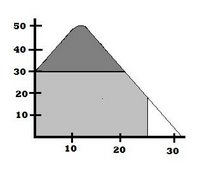http://odeo.com/
http://www.ourmedia.org/
http://filelodge.bolt.com/index.php
http://www.mediamax.com/
http://audacity.sourceforge.net/
The Flight of Wocertine!
Last week, Wocertine decided to go on vacation to take a break from all of his math stuff, but she returned and wants to tell all of us about her flying adventure. On the way to Ohio, Wocerine met a magic an named Sam. Sam told Wocertine that he would give her the ability to fly if she would give him a glass of milk. Woc, always wanting to try neew things, decided to take Sam up on his offer so paid with the milk. He told her that he would raise her on a platform and then when the platform reached thirty feet, she would be able to fly. She stepped onto the platform and raised it. When the height of the platform reached thirty feet , she began to fly as he had foretold. Her path was given by the equation: y=-0.128x2+3.2x+30. For some magical reason Woc could not fly below the height of the platform. Find the area betweem Woc's flight path and the platform.
 Calculation:
Calculation:Y1=-0.128x2+3.2x+30
WINDOW D=(-10, 35) R=(-5, 50)
ZOOM 0:ZoomFit
2nd CALC 7
Lower Limit? x=0 ENTER
Upper Limit? x=25 ENTER
So the total area (dark gray color)= 1083.3333
The area of the rectangle (light gray color)=l*w=(30)*(25)=750
Therefore the area betweem Woc's flight path and the platform:
1083.3333-750=333.33 ft/s
QUESTIONS
#1) s(t)=t2-3t+1
Find the change in position for t=1 to t=4
s(4)-s(10)
=5- (-1)
=6
So between the interval of t=1 to t=4, the position changed by 6 units.
#2) Suppose a car is moving with non-decreading speed according to this table:

We know this is a MONOTOMIC FUNCTION, which means that it's always increasing.
a) Whats an upper limit for the distance, travelled in the first two seconds?
l*w=36*2=72
b) Determine upper and lower estimate for the change in platform for the first 10 seconds.
LHS=2(30)+2(36)+2(40)+2(48)+2(54)=416
This is the lowest possible change in distance or position where they started and stopped.
RHS=2(36)+2(40)+2(48)+2(54)+2(60)=476
This is the highest possible change in distance or position where they started and stopped.
Now invent two different values for t=1, 3, 5, 7, 9. You cannot pick the middle.
My group solved this problem, this way:
t(1)=(30+36)/2=66/2=33
Since we're not allowed to pick the middle number we just went off by a bit.
LHS t(1)=32, RHS t(1)=35
t(3)=(36+40)/2=76/2=38
LHS t(3)=37, RHS t(3)=39
t(5)=(40+48)/2=88/2=44
LHS t(5)=42, RHS t(5)=46
t(7)=(48+54)/2=102/2=51
LHS t(7)=49, RHS t(7)=53
t(9)=(54+60)/2=124/2=57
LHS t(9)=55, RHS t(9)=59
Our whole class ended up with the following:
LHS RHS MAX ERROR
376 456 30
427 457 30
436 466 30
441 471 30
423 453 30
 Therefore the total change in s'(t)=s(10)-s(o)
Therefore the total change in s'(t)=s(10)-s(o)FUNDAMENTAL THEREOM OF CALCULUS: The integral of a derivitive is the total change in the parent function.
Homework: 3.4 odd #'s
The next scribe shall be Katrin :D

2 comments:
Good job Crystal! Simple and clear, kudos for you.
I just wanted to add something. I remember that we found the "upper limit" for the wocertine question by going to the table of values (2nd table), then finding where y equals 30. That's it! ahha, again, good job.
Nice post Crystal :) I like the fact that you include the actual calculator steps, I find I always make stupid mistakes on the calculator. So it's nice to see the steps. I just have a note about the graph of wocertine's path. The point (20,20) on your graph should be (20,30). That way you get a rectangle under the flight path and you can just subtract it from the area where she flew.
Post a Comment